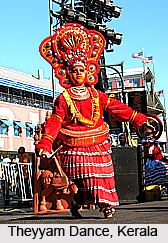 Theyyam is one of the most outstanding and popular ritual arts of northern Kerala, particularly the area of Kolathunadu of the present Kannur and Kasargod District. As a living religious group with centuries old traditions, rituals and customs, it embraces almost all castes and classes of Hindu religion. The term Theyyam is a distorted form of 'Dhaivam' or God. It is a rare combination of dance and music and reflects important features of a tribal culture as a whole. This folk dance is believed to be a divine expression and the local residents of Kerala invoke the blessings of God through this dance form. This custom is also followed in the area of Tulu Nadu in Karnataka.
Theyyam is one of the most outstanding and popular ritual arts of northern Kerala, particularly the area of Kolathunadu of the present Kannur and Kasargod District. As a living religious group with centuries old traditions, rituals and customs, it embraces almost all castes and classes of Hindu religion. The term Theyyam is a distorted form of 'Dhaivam' or God. It is a rare combination of dance and music and reflects important features of a tribal culture as a whole. This folk dance is believed to be a divine expression and the local residents of Kerala invoke the blessings of God through this dance form. This custom is also followed in the area of Tulu Nadu in Karnataka.Origin of Theyyam Dance
Historians are of the view that Theyyam dance is an ancient folk form and possesses characteristics which suggest that it had originated as early as the Chalcolithic and Neolithic periods. There existed certain communities who refused to accept the supremacy of Brahmins, especially in temple worship. These people were major patrons of Theyyam, and this dance used to be practised by every Tharavadu. Brahmins were never permitted to participate in this dance form, as it belonged exclusively to the regional tribal communities of Kerala. However, some royal clans erected their individual shrines where Theyyam deities were established. In domestic shrines, Goddesses like Kurathi, Chamundi, Vishnumoorthi, Someshwari and Rakteshwari are appeased. Thus this dance is also based on caste system. Nowadays, Brahmin 'Thanthri' is invited to sanctify the 'Kavu' idols and the Thiyyas perform this dance as a significant religious custom.
Cults of Theyyam Dance
Theyyam dance, being an ancient tribal dance boasts of a widened scope which also includes the religion of Islam. 'Bhagawathi' or the cult of Mother Goddesses plays a significant role on this dance form. Besides Goddesses, other cults of Theyyam include serpent -worship, tree-worship, ancestor-worship, 'masathi'-worship, animal worship, Goddess of disease, spirit-worship and worship of village deity or 'Gramadevataa'. 'Shivani'or Durga, 'Vaishnavi' or Lakshmi and 'Brahmani' or Saraswati are the major Goddesses worshipped through Theyyam. The Theyyam deities who are worshipped by a cock sacrifice are not allowed to enter shrines. During the 13th century, Vaishnavism was a popular theme of Theyyam, in Tuluva region, under the reign of Vishnuvardhana belonging to Hoysala Dynasty. Shaktism and Shaivism are the other important categories of Theyyam.
For more, visit the link below: